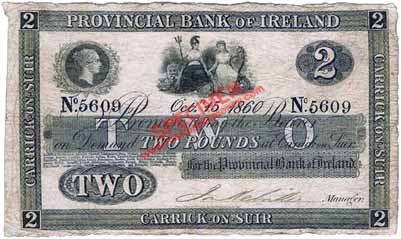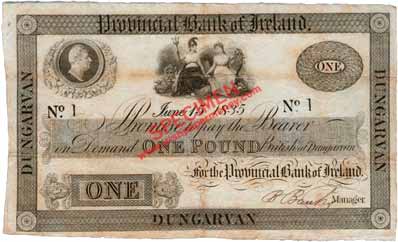
The Provincial Bank of Ireland opened 1 September 1825 in Cork and started to issue Irish banknotes shortly thereafter.
Issued uncanceled examples of single branch Provincial Bank of Ireland banknotes of Series A are generally rare. However, cancelled notes are common, almost all of which have been split and rejoined.
It is said that many Provincial Bank of Ireland banknotes prior to ca.1900 were split down the middle for transportation as separate halves for security reasons, and later rejoined for reissue. This reuse of split and rejoined notes may or may not have been the case. However, it is likely that on being rejoined these banknotes would have had their serial numbers rematched were they intended for reissue, the number being an important security device on Irish banknotes.
A large quantity of cut-cancelled half notes issued by the Provincial Bank of Ireland turned up around 1970. These were on sale in several of the numismatic shops in Dublin at the time as split and rejoined notes, and have been commonly available ever since. It would appear that from observation most of the split and rejoined notes extant are those that had been previously cut-cancelled and then rejoined ca.1970 using modern stamp paper or tape for collecting purposes, making cancelled rejoined notes with mismatching serial numbers quite common. They were sold inexpensively at the time as examples of Provincial Bank of Ireland banknotes. Split and rejoined notes have been recorded with dates up ti 1922.
A considerable number of cut up and joined Provincial Bank of Ireland banknotes have had their serial numbers altered with so that they appear to match. Some rejoined notes consist of more than two parts. Many examples of these cancelled Irish banknotes exist.
Very few cut and rejoined banknotes issued by other banks have been recorded. There is one example of a Bank of Ireland £10 note which has been cut and rejoined with matching serial numbers, this note has not been marked cancelled. There are also a few recorded examples of cut and cancelled Irish banknotes issued by the National Bank of Ireland, as well as some cut and rejoined notes of the bank which appear to not be cancelled.
Provincial Bank of Ireland banknotes of denominations up to £20 were of a similar design with a border around each note. £50 and £100 notes issued by the bank were of a different design, being plainer with the bust of the Monarch on the left.
The date ranges of Provincial Bank of Ireland banknotes with portraits of King William IV and Queen Victoria overlap by a few years, likely due to notes bearing the former portrait being used up after the commencement of Victoria’s reign.
Uniface. Banknotes vary in size (Large size, except where stated). The head office of the Provincial Bank of Ireland is not listed on the notes.
A vignette of Britannia with a Lion and Hibernia is in the centre of each banknote on denominations up to £20, except for Type B. The denomination in words is on the right hand side.
All notes are stated as being payable in 'Pounds British'.
There are seven Types by major design variation for Series A banknotes, as listed below.
Bank title in Serif Upper Case Script in top border.
Portrait in oval at left, with branch of issue to the right of it. Britannia and Hibernia vignette absent from the centre of the note.
Bank title in Oblique Serif Upper Case Script in top border.
Branch of issue is engraved in solid lettering on the left, right and bottom borders.
Portrait of Monarch changed to a bust in a circle and surrounded by a wreath.
Bank title in Gothic Script in top border.
Bank title in Gothic Script in top border. Branch of issue is engraved in solid lettering.
Branch of issue is engraved in outline lettering on the left, right and bottom border.
Type F1. Denominated variously in 'Pounds British'.
Type F2. Denominated variously in 'Pounds'.
An additional printing of all 44 of the branches of the Provincial Bank of Ireland is added on bottom left of each banknote.
Dates on these Irish banknotes range from 1848 to 1869. It is likely that this printing of all the branches on older notes was to facilitate the wider usage of unissued older notes as the bank moved to a multibranch General Issue. This has also been seen on Irish banknotes of the era printed by the National Bank of Ireland.
Type A
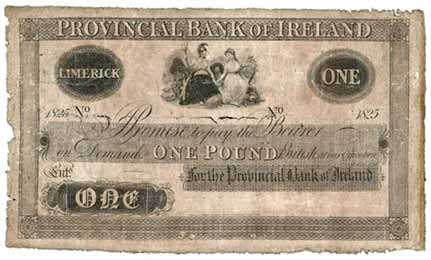
Type B
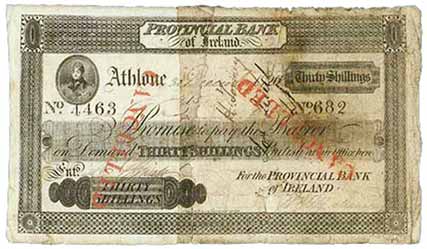
Type C
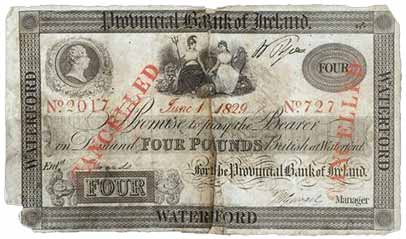
Type D

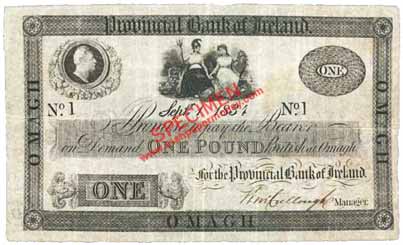
Type E
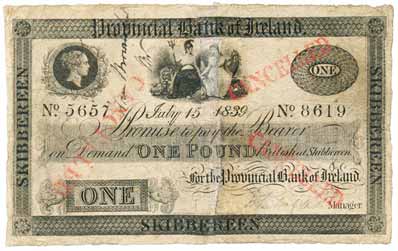
Type F
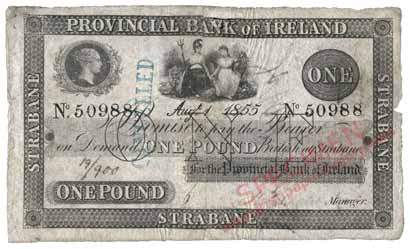
Type G
